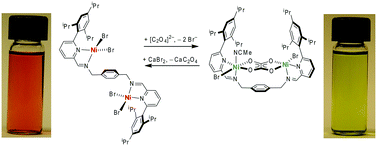Our first research project investigates metal-metal and metal-ligand cooperativity in the activation of small molecules and catalysis. We have previously demonstrated mono- and di-nickel mediated activation of carbon disulfide, assisted by redox-active iminopyridine and bis(imino)pyridine ligands. We have also described cooperative bimetallic systems for oxalate detection and efficient cyclotrimerization catalysis. As part of our collaborative project with BASF North America, we have investigated stabilization of 4,4’-MDI (methylene diphenyl diisocyanate, used as the linker of choice in the synthesis of polyurethanes) via reversible coordination to bimetallic platforms.
Our current research efforts in this project focus on the cooperative heterobimetallic reactivity associated with Mo-Cu CO dehydrogenase (CODH). Mo-Cu CODH from aerobic bacteria such as Oligotropha Carboxidovorans is an enzyme that oxidizes CO to CO2, thereby helping to remove significant amounts of this toxic gas from the atmosphere. CO oxidation takes place at a unique heterobimetallic active site containing nucleophilic Mo(VI)-oxo bridged via a single sulfido to low-coordinate Cu(I). Both metals are required for CO oxidation, suggesting cooperative bimetallic reactivity. Our goals in this project are to (1) decipher the mechanism by which the cooperative action of two different metals allows efficient CO oxidation, and (2) to develop a bioinspired molecular catalyst for CO remediation. Towards these goals, we design heterodinucleating ligands enabling selective coordination of Mo(VI)/Cu(I) (and related metals), and investigate their reactivity with CO and related substrates.







